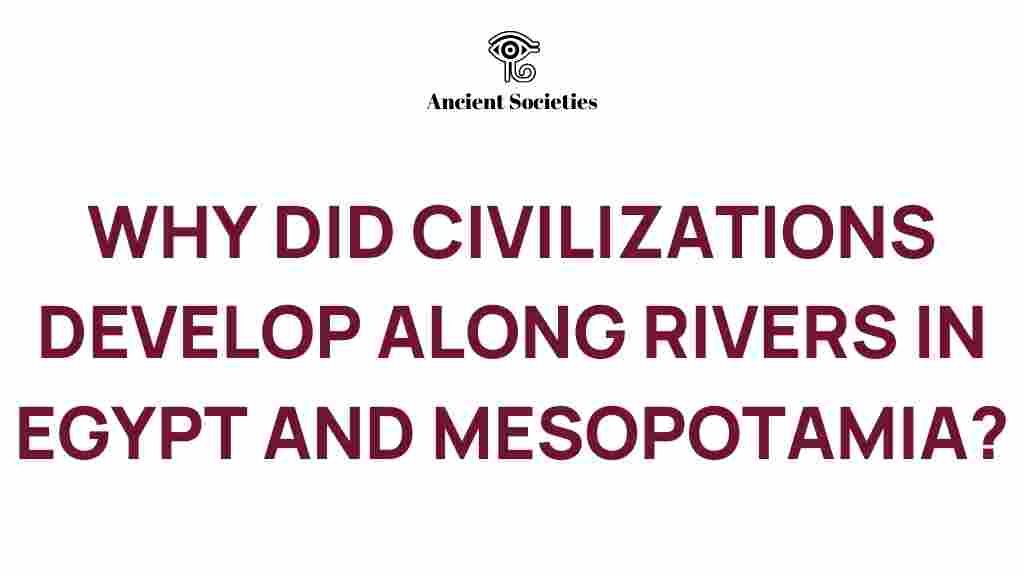The Lifeblood of Ancient Civilizations: Rivers of Egypt and Mesopotamia
The rivers of ancient civilizations have played a pivotal role in shaping the history, culture, and economy of their respective regions. In the case of Egypt and Mesopotamia, the rivers not only provided a source of water but also became the backbone of agriculture, trade, and social development. This article delves into the significance of these rivers, exploring how they influenced the geography, culture, and history of ancient Egypt and Mesopotamia.
The Geography and Rivers of Egypt
Egypt is primarily defined by the Nile River, which is one of the longest rivers in the world. Flowing north for about 6,650 kilometers, the Nile traverses through various landscapes before emptying into the Mediterranean Sea. The unique geography of Egypt, dominated by desert, made the Nile a crucial resource for the ancient Egyptians.
- The Nile River: The lifeblood of Egypt, the Nile provided fertile land along its banks due to the annual flooding that deposited nutrient-rich silt.
- Delta Region: As the Nile approaches the Mediterranean, it splits into several branches, creating a delta that was ideal for agriculture.
Without the Nile, the harsh desert surrounding it would have made agriculture nearly impossible, and thus, the river was central to Egypt’s agricultural practices.
The Importance of Agriculture in Ancient Egypt
Agriculture in ancient Egypt was heavily reliant on the Nile River. The river’s flooding cycle dictated the agricultural calendar, and the people developed sophisticated irrigation techniques to maximize their yields. The key crops included:
- Wheat: A staple food that was essential for making bread.
- Barley: Used for both food and brewing beer.
- Flax: Cultivated for its fibers, used to make linen.
These crops supported a growing population and allowed for trade with neighboring regions, further enhancing the strength and stability of ancient Egyptian civilization.
The Role of the Nile in Trade and Economy
The Nile River facilitated trade, connecting various regions of Egypt and enabling the exchange of goods. Boats could easily navigate the river, transporting goods such as:
- Grain: A major export that was traded for other goods.
- Papyrus: Used for writing and as a medium of exchange.
- Gold and Precious Stones: Sourced from the deserts and traded with other civilizations.
This trade network contributed to the wealth and power of ancient Egypt, making it one of the most formidable civilizations of its time.
The Cultural Significance of the Nile
The Nile River was not just a physical resource; it held immense cultural significance. The ancient Egyptians worshiped the river as a deity, reflecting their deep connection to it. Key aspects included:
- Religion: The Nile was associated with various gods, including Hapi, the god of the annual flooding.
- Mythology: The river featured prominently in myths and legends, symbolizing life and fertility.
- Art and Literature: The Nile inspired countless artistic and literary works that celebrated its life-giving properties.
Thus, the Nile was woven into the very fabric of Egyptian identity.
The Rivers of Mesopotamia: Cradle of Civilization
In contrast, Mesopotamia, often referred to as the “cradle of civilization,” was situated between the Tigris and Euphrates rivers. These rivers provided the necessary resources that allowed ancient civilizations such as the Sumerians, Akkadians, Babylonians, and Assyrians to flourish.
The Geography of Mesopotamia
Mesopotamia’s geography is defined by its river systems:
- Tigris River: Flowing through modern-day Iraq, the Tigris is known for its swift current.
- Euphrates River: Running parallel to the Tigris, the Euphrates is longer and has a slower flow.
The interaction between these two rivers created a fertile crescent, where agricultural practices thrived.
Agricultural Innovations in Mesopotamia
Mesopotamia’s agricultural success can be attributed to the irrigation techniques developed by its inhabitants. The rivers provided water for crops, leading to the cultivation of:
- Wheat and Barley: Essential staples that formed the basis of the diet.
- Legumes: Such as lentils and chickpeas, which added protein to their diets.
- Dates: A significant fruit crop that was cultivated extensively.
The agricultural surplus allowed Mesopotamia to support a complex society, leading to the development of cities and trade.
The Role of Rivers in Trade and Economy
The rivers of Mesopotamia were vital for trade, facilitating the movement of goods between cities and regions. Important trade commodities included:
- Textiles: Wool and linen were produced and traded widely.
- Metals: Copper and tin were exchanged with neighboring regions for tools and weapons.
- Grain: A significant export that was traded for various goods.
Trade routes established along these rivers contributed to the wealth and cultural exchange between ancient civilizations.
Cultural and Historical Significance of the Tigris and Euphrates
The rivers were integral to the cultural and historical development of Mesopotamia. Key points include:
- Writing and Record Keeping: The Sumerians developed cuneiform, one of the earliest writing systems, to keep records of trade and agriculture.
- Legal Systems: The famous Code of Hammurabi was created in Babylon, showcasing the need for a structured society.
- Religion and Mythology: The rivers were personified in various deities, reflecting their importance to everyday life.
The cultural achievements of Mesopotamia, from literature to mathematics, were heavily influenced by the presence of the Tigris and Euphrates rivers.
Conclusion
The rivers of Egypt and Mesopotamia were the lifeblood of their respective ancient civilizations, providing not only sustenance but also a foundation for trade, culture, and societal development. The Nile River enabled the flourishing of ancient Egypt, while the Tigris and Euphrates rivers nurtured the growth of Mesopotamia. These waterways shaped the geography, culture, and history of their regions, leaving a lasting legacy that continues to be studied and admired today.
For more information on the impact of rivers on ancient civilizations, you can visit this resource. If you’re interested in exploring further topics on ancient history, check out this article for additional insights.
This article is in the category History and created by AncientSocieties Team
